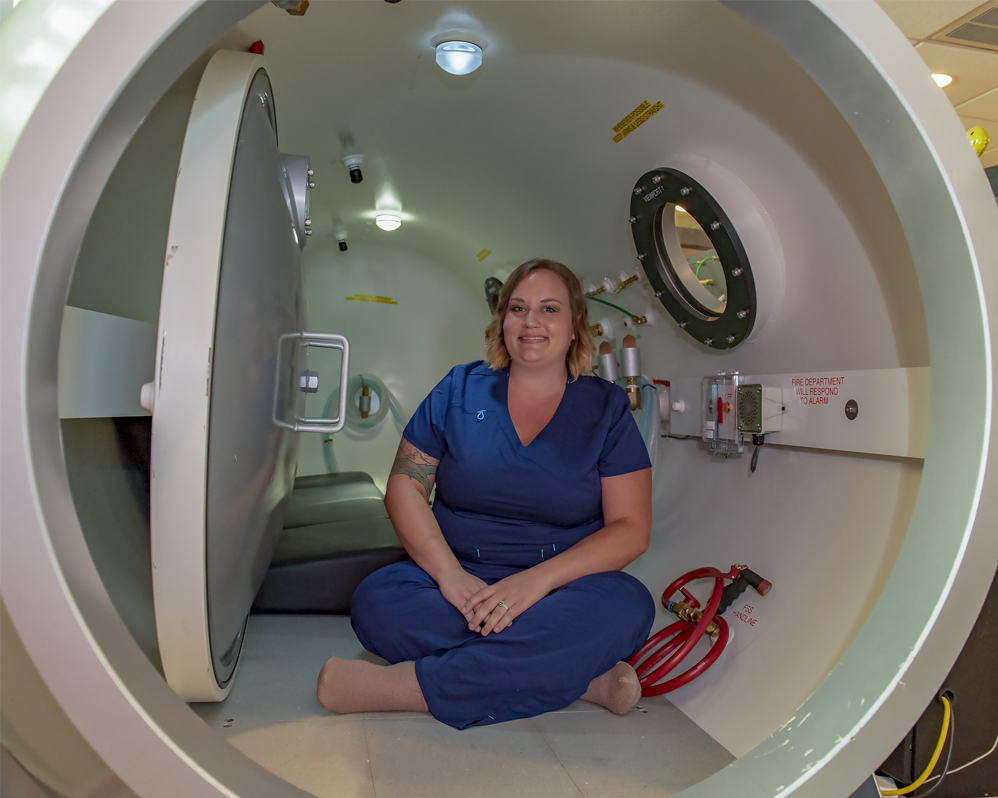Hyperbaric Oxygen Therapy
HBOT repairs damage from illness, injury and disease

About the Treatment
Most people only know about hyperbaric oxygen therapy for treatment of the “bends” in scuba divers. The truth is, hyperbaric oxygen therapy (HBOT) has been used since the 1800’s to help the body heal. It consists of breathing 100% Oxygen (as opposed to the normal 21% we breathe in regular air) at a prescribed depth, for a prescribed period of time.
Hyperbaric oxygen therapy helps create functions such as angiogenesis, neuroplasticity and stem cell mobilization in order to help the body heal.
If you are interested in receiving hyperbaric oxygen therapy or have any questions, call us at 757-452-3934 today to schedule a consult or to learn more.
A Simple Process
- Obtain a prescription for hyperbaric oxygen therapy through one of our in-house doctors for $175
- Coordinate your schedule with the scheduled dives (we have a minimum of 5 dive times per day);
- Determine if you’d like to receive treatment in our mono-place chamber or our multi-place chamber;
- Determine the payment option that works best for you and start your treatment!
How HBOT Works
The pressure that is created in the dive chamber allows the healing oxygen to permeate through all fluids, muscle, tissue, fat and bone through out the entire body. Typically, when our body is injured, the injured tissue does not receive the oxygen it needs to thrive, cells do not function properly and the bodily functions decline. Studies show that hyperbaric oxygen therapy helps the body heal its injuries and improve functionality once again.
HBOT has been shown to work at the mitochondrial level to “kick start” functionality. It has also been shown in to:
- Create new blood vessels (a process called angiogenesis)
- Stimulate new capillary growth
- Improve neuroplasticity
- Increase stem cell mobilization by 800%
- Decrease inflammation and lactic acid
- Increase white blood cell production
- Enhance the ability for white blood cells to carry away “bad” bacteria and debris (Leukocyte activity)
- Decrease surgery complications for smokers
- Improve bone regeneration for faster recovery
- Reduce swelling
- Reduce edema
- Increase the production of collagen
What We Treat
At Tier 1 Therapy Centers, we see patients with many different health issues and wellness goals. Most commonly we see patients for health indications that are NOT covered by insurance, such as:
- Athletic injury/ recovery/performance
- Cerebral Palsy
- Chronic pain
- Detoxification and wellness
- Inflammatory bowel disease
- Crohn’s Disease
- Ulcerative colitis
- Diverticulitis
- Fibromyalgia
- Lyme Disease
- Multiple Sclerosis
- Mild traumatic brain injury
- including concussion
- post concussive syndrome
- stroke
- Peripheral neuropathy, especially as a result of
- Chemotherapy
- Diabetes
- Pre and post surgery
- Cosmetic surgery
- Hip replacement
- Shoulder surgery
- Ligament repair
- Dental surgery
- Child birth
- Natural and C-section
- Stroke
We also can treat for the indications that ARE covered by insurance and medicare, though we do not process insurance claims at this time. There are two reasons that patients chose to receive therapy here WITHOUT INSURANCE COVERAGE, as opposed to in the hospital setting, WITH INSURANCE COVERAGE:
Those health indications that are covered are by medicare and / or other insurance carriers (as listed on https://www.cms.gov/Regulations-and-Guidance/Guidance/Transmittals/downloads/R129CIM.pdf):
l. Acute carbon monoxide intoxication, (ICD-9 -CM diagnosis 986).
2. Decompression illness, (ICD-9-CM diagnosis 993.2, 993.3).
3. Gas embolism, (ICD-9-CM diagnosis 958.0, 999.1).
4. Gas gangrene, (ICD-9-CM diagnosis 0400).
5. Acute traumatic peripheral ischemia. HBO therapy is a valuable adjunctive treatment to be used in combination with accepted standard therapeutic measures when loss of function, limb, or life is threatened. (ICD-9-CM diagnosis 902.53, 903.01, 903.1, 904.0, 904.41.)
6. Crush injuries and suturing of severed limbs. As in the previous conditions, HBO therapy would be an adjunctive treatment when loss of function, limb, or life is threatened. (ICD-9- CM diagnosis 927.00- 927.03, 927.09-927.11, 927.20-927.21, 927.8-927.9, 928.00-928.01, 928.10- 928.11, 928.20-928.21, 928.3, 928.8-928.9, 929.0, 929.9, 996.90- 996.99.)
7. Progressive necrotizing infections (necrotizing fasciitis), (ICD-9-CM diagnosis 728.86).
8. Acute peripheral arterial insufficiency, (ICD-9-CM diagnosis 444.21, 444.22, 444.81).
9. Preparation and preservation of compromised skin grafts (not for primary management of wounds), (ICD-9CM diagnosis 996.52; excludes artifical skin graft). 10. Chronic refractory osteomyelitis, unresponsive to conventional medical and surgical management, (ICD-9-CM diagnosis 730.10-730.19). Rev. 129
10. Chronic refractory osteomyelitis, unresponsive to conventional medical and surgical management, (ICD-9-CM diagnosis 730.10-730.19). Rev. 12935-10 (Cont.)
11. Osteoradionecrosis as an adjunct to conventional treatment, (ICD-9-CM diagnosis 526.89).
12. Soft tissue radionecrosis as an adjunct to conventional treatment, (ICD-9-CM diagnosis 990).
13. Cyanide poisoning, (ICD-9-CM diagnosis 987.7, 989.0).
14. Actinomycosis, only as an adjunct to conventional therapy when the disease process is refractory to antibiotics and surgical treatment, (ICD-9-CM diagnosis 039.0-039.4, 039.8, 039.9).